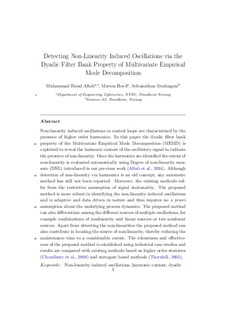| dc.contributor.author | Aftab, Muhammad Faisal | |
| dc.contributor.author | Hovd, Morten | |
| dc.contributor.author | Sivalingam, Selvanathan | |
| dc.date.accessioned | 2018-01-24T14:46:19Z | |
| dc.date.available | 2018-01-24T14:46:19Z | |
| dc.date.created | 2018-01-08T11:55:34Z | |
| dc.date.issued | 2017 | |
| dc.identifier.citation | Journal of Process Control. 2017, 60 68-81. | nb_NO |
| dc.identifier.issn | 0959-1524 | |
| dc.identifier.uri | http://hdl.handle.net/11250/2479513 | |
| dc.description.abstract | Non-linearity induced oscillations in control loops are characterized by the presence of higher order harmonics. In this paper the dyadic filter bank property of the multivariate empirical mode decomposition (MEMD) is exploited to reveal the harmonic content of the oscillatory signal to indicate the presence of non-linearity. Once the harmonics are identified the extent of non-linearity is evaluated automatically using degree of non-linearity measure (DNL) introduced in our previous work [11]. Although detection of non-linearity via harmonics is an old concept; any automatic method has still not been reported. Moreover, the existing methods suffer from the restrictive assumption of signal stationarity. The proposed method is more robust in identifying the non-linearity induced oscillations and is adaptive and data driven in nature and thus requires no a priori assumption about the underlying process dynamics. The proposed method can also differentiate among the different sources of multiple oscillations, for example combinations of nonlinearity and linear sources or two nonlinear sources. Apart from detecting the non-linearities the proposed method can also contribute in locating the source of non-linearity, thereby reducing the maintenance time to a considerable extent. The robustness and effectiveness of the proposed method is established using industrial case studies and results are compared with existing methods based on higher order statistics [7] and surrogate based methods [8]. | nb_NO |
| dc.language.iso | eng | nb_NO |
| dc.publisher | Elsevier | nb_NO |
| dc.title | Detecting non-linearity induced oscillations via the dyadic filter bank property of multivariate empirical mode decomposition | nb_NO |
| dc.type | Journal article | nb_NO |
| dc.description.version | submittedVersion | nb_NO |
| dc.source.pagenumber | 68-81 | nb_NO |
| dc.source.volume | 60 | nb_NO |
| dc.source.journal | Journal of Process Control | nb_NO |
| dc.identifier.doi | 10.1016/j.jprocont.2017.08.005 | |
| dc.identifier.cristin | 1537584 | |
| dc.description.localcode | This is a submitted manuscript of an article published by Elsevier Ltd in Journal of Process Control, 13 September 2017. | nb_NO |
| cristin.unitcode | 194,63,25,0 | |
| cristin.unitname | Institutt for teknisk kybernetikk | |
| cristin.ispublished | true | |
| cristin.fulltext | preprint | |
| cristin.qualitycode | 2 | |
